Nails are the last thing to grow back after an injury or illness, so they’re a great indicator of your overall health and well-being. They usually grow at a rate of about 0.1 mm per day, which is why they are such a good way of knowing how your body is functioning.
Nails also have nerves that send information back to the brain when they are touched or injured. This can be useful if you want to know whether an injury is serious!
Table of Contents
Things Your Nails Can Tell You About Your Health
Nails can be affected by diseases such as psoriasis, diabetes, and kidney disease. They can also reveal whether you have any deficiencies in key nutrients like zinc, iron, or vitamin B12. Here are some of the ways your nails might be trying to show about your body:
Yellow nails
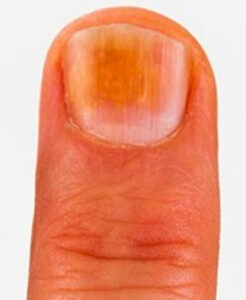 Yellow or yellowish nails can be caused by several conditions and might even indicate an underlying medical condition. Yellow nails are a common problem among people. This can be either due to fungal infection or it can be a sign of smoking too many nicotine cigarettes.
Yellow or yellowish nails can be caused by several conditions and might even indicate an underlying medical condition. Yellow nails are a common problem among people. This can be either due to fungal infection or it can be a sign of smoking too many nicotine cigarettes.
Fungal infection, which is often referred to as onychomycosis, is one of the most common reasons for having yellow nails. This type of infection occurs when there are some fungal spores present in your nail bed. These spores will grow and cause inflammation within your nails, resulting in yellow discoloration.
Another reason why you may have yellow nails is because of nail biting. When you bite your nails, it often leads to a yellow discoloration due to the presence of bacteria and keratin debris inside the nail bed.
White spots
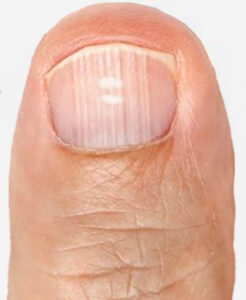 White spots on nails are usually caused by damage to the nail. The damage can be caused by a lack of nutrients present in the body, repeated exposure to chemicals, or even bacterial infection. White spots on the nails can also be a sign of an underlying health problem like diabetes or kidney disease.
White spots on nails are usually caused by damage to the nail. The damage can be caused by a lack of nutrients present in the body, repeated exposure to chemicals, or even bacterial infection. White spots on the nails can also be a sign of an underlying health problem like diabetes or kidney disease.
Dry skin can also lead to white spots on your fingernails. The main cause of this is having too much calcium in your body. Calcium is important for building strong bones and teeth, but too much calcium can build up inside your body and cause problems with other organs as well such as your heart and kidneys.
Nail psoriasis is another common condition that causes white spots to appear on the nail. This is more common in people with diabetes or a weakened immune system. It causes skin cells to grow abnormally and build up under the nail. This eventually reveals the nail bed beneath your fingernail or toenail, also causing it to become thicker than usual.
Cracked or brittle nails
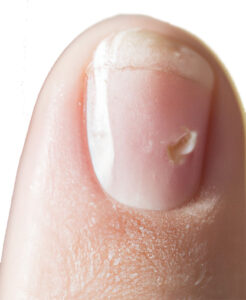 As you get older, your nails become more brittle and prone to cracking or breaking. This is due to a decrease in keratin, a protein that makes up about 90% of your nail’s mass. As you age, you produce less keratin and your nails become thinner, more fragile, and more likely to split or break.
As you get older, your nails become more brittle and prone to cracking or breaking. This is due to a decrease in keratin, a protein that makes up about 90% of your nail’s mass. As you age, you produce less keratin and your nails become thinner, more fragile, and more likely to split or break.
Cracked or brittle nails are usually caused due to trauma. If you have hit your nail on something hard, it may crack or break. This type of injury usually damages the nail that does not affect its appearance much. However, if the nail separates from the nail bed, this is an emergency situation that requires immediate medical attention.
Some medications can cause nail changes in rare cases, including psoriasis drugs like methotrexate and antifungal medications like terbinafine. If you’re taking a medication known to affect your nails, talk with your doctor before stopping it because doing so may make things worse if you have an underlying condition that’s causing the problem.
Discolored nails
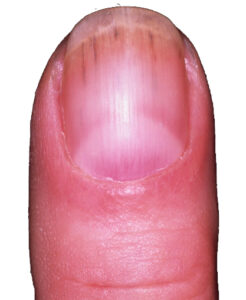 The most common cause of discolored nails is a splinter hemorrhage. A splinter hemorrhage can occur when you accidentally scratch your finger or thumb with a sharp object, such as a utensil or fingernail.
The most common cause of discolored nails is a splinter hemorrhage. A splinter hemorrhage can occur when you accidentally scratch your finger or thumb with a sharp object, such as a utensil or fingernail.
The blood vessels under your nail swell and become inflamed because of the injury. The blood that leaks out into the surrounding tissue causes it to look blue or purple in color, which makes the nail look discolored.
Splinter hemorrhages are harmless and will go away on their own without treatment. They don’t require any special care, but you should avoid picking at your nails so you don’t make them worse.
Discolored nail lines, however, are far more dangerous. These dark lines are one sign of melanoma, which is a type of skin cancer. Discolored nail lines often come up during a checkup at the doctor’s office. Sometimes they’re hard to see, but they may be noticed during a physical exam. You could be checking yourself for signs and symptoms of skin cancer, or your doctor might notice the discoloration while examining your nails for other problems.
The most common type of discoloration is brown or black streaks running through the nail bed. It might look like a dark shadow across part of your nail bed or on all four corners of an individual nail. This type of melanoma usually isn’t painful or itchy but it can cause bleeding and pain if it grows into surrounding tissue or bone.
Pitted nails
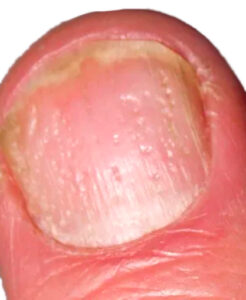 Nail pitting is a condition that causes a small indentation, or pit, to appear on the surface of the nail. Pitted nails are more common in people who have psoriasis, eczema, and some other skin conditions.
Nail pitting is a condition that causes a small indentation, or pit, to appear on the surface of the nail. Pitted nails are more common in people who have psoriasis, eczema, and some other skin conditions.
Nails can also become pitted if you bite them or overuse nail polish remover. The chemicals in nail polish remover can cause your nails to become weak and brittle and more susceptible to developing holes. If you use nail polish remover too often, it can cause your nails to develop discoloration along the ridges of your nails. This is also known as mechanical stress.
There are many treatment options for pitted nails including topical treatments such as lotions or creams or prescription medications that help strengthen the nail and improve its appearance.
Ridged nails
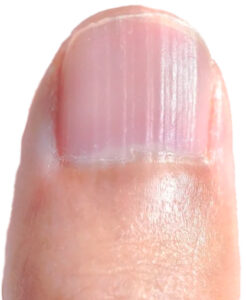 Ridges on nails can be a sign of many different conditions. They can be due to damaged cuticles or skin, as well as infection. Nails can also become ridged due to certain vitamin deficiencies or an autoimmune disease.
Ridges on nails can be a sign of many different conditions. They can be due to damaged cuticles or skin, as well as infection. Nails can also become ridged due to certain vitamin deficiencies or an autoimmune disease.
The most common cause of ridged nails is injury or trauma to the nail bed, which is the soft tissue that grows out from under the nail plate. Trauma can occur when you hit your finger or toe against something hard and cause bleeding under the nail plate. The blood clot that forms over time becomes encased in the growing nail and appears as a dark line. If this happens repeatedly over time, it can lead to permanent nail changes such as ridges or grooves.
Other causes include a lack of moisture in your skin and nails can lead to cracks and fissures, which are more vulnerable to injury. Dry skin also makes it harder for your body to create new cells, which may contribute to ridges forming on your nails.
Bluish nails
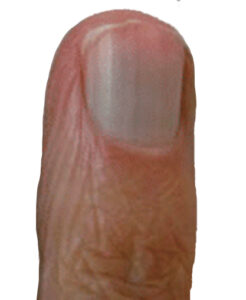 Blue nails may be caused by several factors. The most common is poor circulation in the fingers, which leads to an increase in hemoglobin in the blood vessels that supply the nail bed. This causes them to appear blue or grayish-blue on top, with a white tip on the end.
Blue nails may be caused by several factors. The most common is poor circulation in the fingers, which leads to an increase in hemoglobin in the blood vessels that supply the nail bed. This causes them to appear blue or grayish-blue on top, with a white tip on the end.
Bleeding under your nails can also lead to bluish discoloration over time. Minor injuries such as hurting your finger or bumping into something can cause bruising underneath your nail plate.
This bruising can be painful and tender for several weeks, leading to a dark blue coloration in the affected area. If you have any suspicion that this is what’s causing your bluish nails, see your doctor to rule out other possible conditions like osteoarthritis or arterial disease.
Nail biting
Nail biting is generally an impulse control disorder that may have emotional roots. When feeling anxious or stressed, it’s easy to resort to an activity like nail biting as a way of calming down. The same thing happens when feeling bored or lonely. Some people find comfort in chewing on their nails or doing to help them focus on something besides what they’re feeling.
Nail biting is a very common problem. About 10% of adults bite their nails, and about 25% of children do it. Biting your nails can cause bleeding, excessive nail splitting and breakage, and sometimes even infection.
If you bite your fingernails frequently enough, it can damage them so much that they become permanently deformed and unable to grow properly again. If this happens, you might have trouble growing new healthy fingernails because they don’t have enough material left in them for growth. They may also be more susceptible to infections because there’s less protection over the sensitive tissues beneath the surface of the nail plate.
Reddish nails
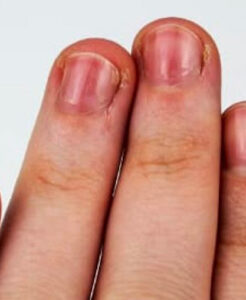 It’s important to remember that not all reddish nails are a sign of poor health. But if you notice any other symptoms along with red nails such as pain, swelling, or tenderness then it’s time to see your doctor.
It’s important to remember that not all reddish nails are a sign of poor health. But if you notice any other symptoms along with red nails such as pain, swelling, or tenderness then it’s time to see your doctor.
People who bite their nails might also have a reddish color under their fingernails because they’ve been biting too hard. Biting down on your nails can cause them to bleed or tear open, so that blood flows into the matrix under them. It usually goes away when you stop biting your fingernails because the bleeding stops and the cells grow back normally.
Conclusion
Just like our other body parts, the state of our nails is a reflection of our overall health. Our nails reflect the underlying structure of our hands and fingers, and any abnormality in their condition may be an indication of some underlying medical complication.
If you notice irregularities in your fingernails maybe it’s time to give a quick visit to your doctor!